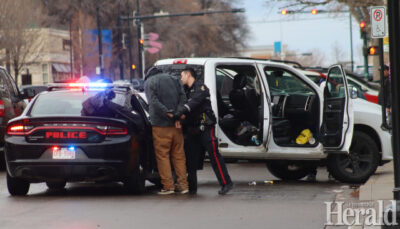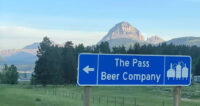Terms of reference set for lawlessness task force
By Al Beeber - Lethbridge Herald on November 16, 2023.
 Herald file photo
Lethbridge police take a person into custody during a call downtown. Terms of reference have been developed for a Downtown Lethbridge Lawlessness Task Force that was recently approved by council.
Herald file photo
Lethbridge police take a person into custody during a call downtown. Terms of reference have been developed for a Downtown Lethbridge Lawlessness Task Force that was recently approved by council.LETHBRIDGE HERALDabeeber@lethbridgeherald.com
The terms of reference have been developed for the Downtown Lethbridge Lawlessness Task Force that was recently approved by council.
The cross functional team approach has several key elements, Acting Mayor John Middleton-Hope said Wednesday before city council began holding its second day of discussions as Economic and Finance Standing Policy Committee.
The task force will include members of City administration, police, Fire/EMS, Regulatory Services and representatives from the Downtown Business Revitalization Zone.
The terms of reference will be brought to city council at its meeting on Dec. 12.
Lawlessness, said Middleton-Hope, is defined as “a state of disorder due to a disregard of the law. These behaviours include criminal, uncontrolled and anti-social behaviours that have a sustained and pervasive impact on communities.”
The task force will identify the top 20 issues then prioritize them, said the Acting Mayor. Among the priorities to be addressed is what he calls a huge increase in fires in the downtown core which included the destruction of the historic Bow On Tong building and the Lethbridge Hotel earlier this year.
Another issue is the use of shopping carts to convey belongings and other materials. This was the focus of an official business motion Middleton-Hope tried to convince council to approve nearly two years.
“We need to reduce the likelihood of people taking carts,” said Middleton-Hope who pointed out that the majority of discarded carts in north Lethbridge are coming from three businesses in one strip mall.
Not only are the carts being used to carry belongings but also to haul needles, crack pipes and bio-hazardous materials.
“It’s one of the conveyance methodologies that people use with alacrity moving items around the city and they usually end up abandoned, they usually end up damaged, there’s a cost associated with them. So we need to work with businesses to reduce the likelihood that people are going to be able to walk off a lot with shopping carts,” said Middleton-Hope.
“It’s changing the mindset of our citizens, it’s changing the mindset of the people living on the street or committing crime on the street. We want to reduce the lawlessness,” he said.
The task force will be addressing problems on two fronts, locally and provincially.
He said every time resources are put into Calgary and Edmonton, that displaces gangs and crime to mid-sized communities of 50,000 or more in the province.
“The focus of the Government of Alberta has been to resource new strategies for these two cities (Calgary and Edmonton) in an effort to reduce lawless behaviours. And the degree of the effectiveness of this approach has resulted in significant displacement of lawless behaviours to mid-sized cities. There have been increases in violent crime, organized crime, drug trafficking, property crimes, opioid addictions, encampments, homelessness and dangers to police officers, fire and EMS in responding to these events and to our citizens. This approach results in resources to Alberta’s two largest cities while the problems of displacement without adequate resources end up in mid-sized cities,” said Middleton-Hope.
Mid-sized municipalities have about 730,000 residents in total in Alberta and Middleton-Hope says all eight mayors of such cities are board with the proposal to look at lawlessness on a larger scale.
“The City of Lethbridge proposes the development of a collaborative and strategic approach to address the lawless behaviours being experienced by our citizens.” That would include a symposium with mid-sized cities to discuss challenges and best practices and to lobby the province to work with communities on resourcing issues.
“We need to work on solutions for our city,” said Middleton-Hope.
“We’re bringing these communities together,” he said. “We’re doing it at the local level and then we’re going to do it at the provincial level where we discuss strategies that are working, challenges that we’re faced with,” he stated.
The local task force will be “analytically driven” and will include the contract hiring of an analyst who “scrapes” AI data on lawlessness on such issues as crime, bio-hazardous debris recovery and hot spot sites in the city.
The first focus will be on the general parameters of the BRZ which includes an area from 6 Ave. S. to the highway, from Scenic Drive to Stafford Drive.
“The reality is that we’re looking at how do we manage resources. We’re going to take what is known as an appreciative inquiry approach,” which involves getting people from different agencies in a room to identify key issues such as defecation on doorsteps, soiled clothing being left in vestibules and lighting fires in back alleys with pallets, he said.
Fires could be reduced if businesses and downtown residents quit leaving combustible materials such as cardboard and wood in alleys, he said.
The task force will not be looking at homelessness, he noted.
Follow @albeebHerald on Twitter
26-25





[…] the Downtown Lethbridge Lawlessness Task Force was announced recently, several Lethbridge public intellectuals immediately redirected their […]